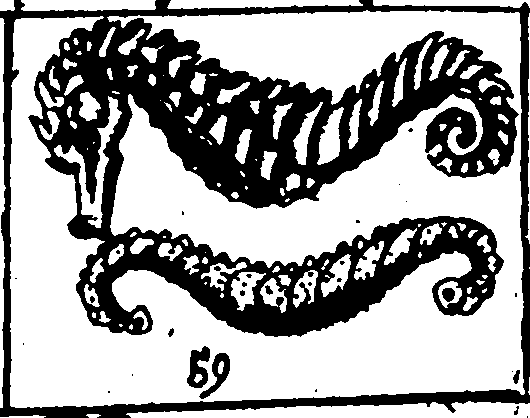Sea-Horse
Randal Holme's Academy of Armory (1688) discusses all manners of
fantastic animals. He distinguishes:
- the sea-horse fish (book II, ch. XVI, n. 5, p. 359):
V. He beareth Argent, a Sea Horse Fish, (or an Hippotame, or Marehorse,
a Water Horse fish, Azure, finned and tusked, Or. This is the forepart of a
Horse, and the hinder of a Fish, which in Heraldry is ever turned up after
this manner, which needs no mentioning in these kind of Water Creatures,
but if they be otherwise, term them according as in the examples given,
chap. 9. numb. 88. sect. 9. and in this chapter numb. 10, 11, 12, 13.
This is the Crest of Waterman. [...]
This is of some termed a Sea Horse Naiant; but that cannot be, except the
tail were extended, as numb. 10. also Antiquity hath given this the name of a
Sea Horse, which I call a Sea-Horse-fish, and that for good reason, which is
to distinguish it from the whole Sea-Horse which hath four feet, as
I have described such creatures of the Sea, numb. 31."

Sea-Horse Fish (Randal Holme, 1688)
- the Sea-Horse (ibid., n. 31, p. 362):
"A Sea or Water Wolf, or Sea Horse, or the like: so termed when
devised by Herauldry, as is aforesaid. Having four Feet Duck like,
and a Fish Tail, as numb. 7.14. chap. 10. numb. 18.20.22.

Sea-Horse (Randal Holme, 1688)
He also mentions the Hippocampus (book II, ch. XV, n. 59, p. 358):
"He beareth Or, a Skelleton of an Hipocampus (or a Sea Horse) Azure. This is taken
so by many, but in truth it is an Insect Vermine of the Sea, whose foreparts are
somthing like a Horse, and hinder parts bend in joynts, having many knotty or
nappy incisures, by means whereof he is able to turn, and wind his Tail round inward.
It is of some called the Sea Salamander, the Sea Dragon, a Sea Asphe. The Germans
call it a Seerossle; but the proper name for it in English is an Hipotamus insect,
or Sea Horse worm. "

Hippocampus (Randal Holme, 1688)
Holme cites Tucker as bearing azure a Chevron Or between 3 sea-horses Argent, and
cites the crest of Cotgrave as On a Sea Horse Fish, a King in Armour sounding of an Horn,
all proper, Bridle G. Or.
The Sea-Horse appears as a crest:
- Jenkinson of Walcot (baronet, May 18, 1661): azure on a fess wavy argent charged with a cross pattee gules,
and in chief two estoils, or. Crest: a hippotomus, or sea-horse, assurgent, or, mained
azure, supporting a cross patee, gules. (Wotton, Thomas. The English baronets, 1727, p 247)
- Thomas Bruce Budenell, cr. Lord Bruce Apr 17, 1746; earl of Aylesbury Jun 8, 1776. Argent a chevron
gules between three steel caps azure with a martlet sable for difference. Crest: on a wreath,
a sea-horse naiant proper, mane and tail or. (Clark 1779, p. 56)
- Page, of Greenwich, cr. baronet Dec 3, 1714: azure a fess indented between three martlets or.
Crest: on a wreath, a demi sea-horse per pale indented or and azure.
It appears as a supporter:
- George Bing, viscount Torrington, baron Byng of Southill (so created Set 9, 1721):
Quarterly Sable and Argent, in the first quarter a lion rampant Argent.
Supported on the dexter side by an antelope ermine, his horns, mane, tuffs and hoofs
topaz, and on the sinister side by a sea horse argent, his mane, and the tip of his tail
as the dexter, each standing on a cannon, proper. Crest, on a wreath of his colours,
an antelope at gaze, as the supporter, and his tail extended.
(Guillim: The banner display'd , 1726-28, vol 2 p. 837; see illustration below).
-
John Nettervile, viscount Nettervile of Douth, in the Co. of Meath, so cr. by K James I.
Argent a cross gules fretty or. Crest, on a wreath of his
colours, a demi lion gules. Suppr on the dexter side by a sea-horse parted per fesse
fules and proper, mane, legs and tip of the tail, or; on the sinister by a lion guardant
gules bezanty. (ibid p. 664).
- Edward Hawke, Lord Hawke of Towton in Yorkshire (cr. May 14, 1776): Argent a chevron erminois
between three boatswain's whistles proper. Supp: dx., a Neptune crowned with an eastern crown, standing
upon a dolphin proper, holding in his right hand a trident; sin., a sea-horse, holding with his
dexter paw a flag. (Clark: The Peerage of the Nobility of England, 1779, p. 95)
Here are a few illustrations from 18th c. heraldry books:

Guillim: The Banner display'd (1726)

Nichols: The British compendium (1725)

Clark: A Short and Easy Introduction to Heraldry (1776)







